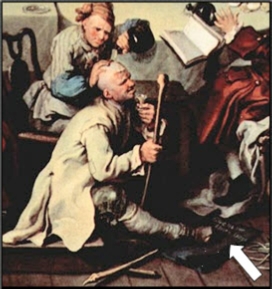


BRITAIN ADOPTS THE GREGORIAN CALENDAR 1752 (G2)
xxxxxAs we have seen, to rectify the calendar instituted by Julius Caesar in 46 BC, Pope Gregory XIII introduced his own one in 1582 (L1). Catholic Europe adopted it almost at once, but Protestant countries were slow to change, and Greece and Turkey did not do so until the 1920s. Britain adopted the Gregorian Calendar in 1752, amid public protest over the loss of eleven days. The new arrangement was beneficial for trade, but at the time it did cause some confusion over the payment of wages and rents! There is still confusion today in that the Jewish calendar starts in 3761 BC (once adjudged the beginning of the world) and the Muslim one in 622 AD, when Muhammad began his mission.
 xxxxxAs we have seen, in 46 BC Julius Caesar introduced a purely solar calendar -
xxxxxAs we have seen, in 46 BC Julius Caesar introduced a purely solar calendar -
xxxxxUnfortunately, the Gregorian calendar was introduced piecemeal throughout the world, and, even today it is not accepted everywhere -
 xxxxxBritain finally altered its calendar in 1752, by which time the deficit had risen to eleven days. At the same time the beginning of the year was put back from the 25th of March to the 1st of January. The change caused riots in the streets, with the crowds demanding "give us back our eleven days!" (the 3rd to the 13th of September inclusive). Some people sincerely believed that their lives had been shortened, whilst others that it was a crafty means of changing the Saints' Days. Such fears were clearly unfounded, but there were genuine causes for concern. In the long term, the new calendar was undoubtedly beneficial to commerce and international relations, but in the short term it caused much confusion and dispute over the payment of wages and rents -
xxxxxBritain finally altered its calendar in 1752, by which time the deficit had risen to eleven days. At the same time the beginning of the year was put back from the 25th of March to the 1st of January. The change caused riots in the streets, with the crowds demanding "give us back our eleven days!" (the 3rd to the 13th of September inclusive). Some people sincerely believed that their lives had been shortened, whilst others that it was a crafty means of changing the Saints' Days. Such fears were clearly unfounded, but there were genuine causes for concern. In the long term, the new calendar was undoubtedly beneficial to commerce and international relations, but in the short term it caused much confusion and dispute over the payment of wages and rents -

 xxxxxAs stated earlier, there are other, wider complications concerning the change made in 1582. The Gregorian calendar is based on the Christian faith, with AD starting at the year of Christ's birth (though this is now believed to be four years out!). The Jewish calendar, on the other hand, takes 3761 BC as its starting point, the date of the beginning of the world according to the Old Testament. To make matters more confusing -
xxxxxAs stated earlier, there are other, wider complications concerning the change made in 1582. The Gregorian calendar is based on the Christian faith, with AD starting at the year of Christ's birth (though this is now believed to be four years out!). The Jewish calendar, on the other hand, takes 3761 BC as its starting point, the date of the beginning of the world according to the Old Testament. To make matters more confusing -
xxxxxBecause the Gregorian calendar still has months of varying length, a number of proposals for calendar reform have been put forward over the years. In 1954, for example, the so-
xxxxxIncidentally, as noted earlier, the change to the Gregorian Calendar in 1582 was only made possible by an accurate knowledge of the year's length. The skilled Danish astronomer, Tycho Brahe, was working at his observatory on the island of Hven at that time. By his observation of the sun, moon and planets over many years, he was able to determine the precise length of the year to within less than a second.
Acknowledgements
Gregory XIII: detail, by the Italian painter Lavinia Fontana (1552-
G2-


